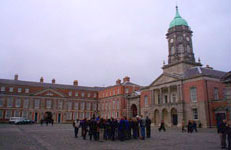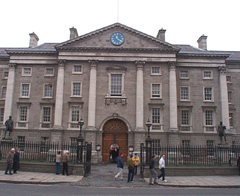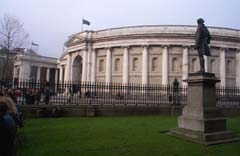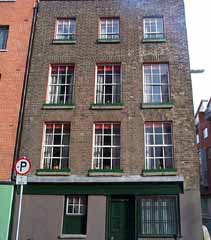Dublin - a historical seminar on the street
 Standing
under the clock tower in the yard of Trinity college, Peter, a History
post-graduate, gives us an introduction to 9000 years of Irish history.
It begins with several smaller groups of hunters and gatherers from Scotland
and England, but the first people really making an impact were the Celts,
coming over from central Europe during the 3rd century BC. They soon became
the dominant culture, shaping Ireland with their habits, language and
art. Actually, both the Irish and the English names for Dublin go back
to Celtic words, the Irish name being Baile Atha Cliath, the English going
back to Dubh Linn, i.e. "Black Pool".
Standing
under the clock tower in the yard of Trinity college, Peter, a History
post-graduate, gives us an introduction to 9000 years of Irish history.
It begins with several smaller groups of hunters and gatherers from Scotland
and England, but the first people really making an impact were the Celts,
coming over from central Europe during the 3rd century BC. They soon became
the dominant culture, shaping Ireland with their habits, language and
art. Actually, both the Irish and the English names for Dublin go back
to Celtic words, the Irish name being Baile Atha Cliath, the English going
back to Dubh Linn, i.e. "Black Pool".
When the Pope in Rome sent his first missionary, St. Patrick, in the 5th ct. AD, the Celts were quite willing to take on the new religion and scholarship grew with the Christian community. This process only came to an end when the Vikings started raiding the settlements along the Irish rivers during the 9th century. They were only driven out by the Anglo-Normans during the 12th century.
We leave our "seminar on the street" for a moment to visit the "Dvlinia" - an interactive museum introducing the visitor to Dublin during the Middle Ages with the aid of a "personal guide" in the form of a Walkman. Large format paintings and scenes with lifelike, live size dolls illustrate the different passages in Dublins history. Several different languages were spoken in Dublin at one time: Priests spoke Latin, merchants a kind of English that would not be understandable today, people of the aristocracy spoke a kind of French and so on. We are told about the black death, spread through rats and fleas and killing one third of the population between 1348-1351. The phrase "bring out your dead" echoed on the streets of Dublin every day as men with carts collected the bodies. Naturally, the conflict between Ireland and Britain comes up repeatedly, and sometimes the Irish way of showing their miscontent with the British developed strange forms, for example when a 10 year old boy was dubbed King of England in Christchurch cathedral. That did not turn out so well for the poor boy who was captured in battle and ended up as a simple servant, supposedly for life, to the "real" king of England.
 Here,
we return to Trinity College, founded in 1592, the very icon of the English
effort to import both English culture and Anglican denomination. James
Joyce, a student of the Irish university in Dublin, UCD, obviously had
strong opinions on this English cultural presence. When Harold Bloom in
Ulysses walks past Trinity, clouds block the sun and Bloom feels
deeply depressed. Only a few blocks on, though, the sun comes out again.
From Trinity, we walk over to the former House of Parliament, which was
the site of Anglo-Protestant power, whereas large parts of Ireland along
the West coast were still Gaelic and Roman Catholic.
Here,
we return to Trinity College, founded in 1592, the very icon of the English
effort to import both English culture and Anglican denomination. James
Joyce, a student of the Irish university in Dublin, UCD, obviously had
strong opinions on this English cultural presence. When Harold Bloom in
Ulysses walks past Trinity, clouds block the sun and Bloom feels
deeply depressed. Only a few blocks on, though, the sun comes out again.
From Trinity, we walk over to the former House of Parliament, which was
the site of Anglo-Protestant power, whereas large parts of Ireland along
the West coast were still Gaelic and Roman Catholic.
 The
House of Parliament was built in 1729 but already closed in 1800 during
the Act of Union, the parliament deciding its own dissolution. No great
loss, according to Jonathan Swift, who commented that this was a house
with "many a head with only a few brains". The building was sold to the
Bank of Ireland under two conditions: firstly, that they would never sell
it, and secondly, that the actual seats of the House of Commons had to
be taken out. Obviously, the English government was worried that, if customers
were allowed to sit in the seats, they might feel the spirit of the parliament
coming back. Dublin lost its status as the "second city in the empire".
It declined to a provincial town, both in economic and socio-cultural
terms. The golden age of Dublin reflected in its Georgian architecture
and vivid cultural life, was over.
The
House of Parliament was built in 1729 but already closed in 1800 during
the Act of Union, the parliament deciding its own dissolution. No great
loss, according to Jonathan Swift, who commented that this was a house
with "many a head with only a few brains". The building was sold to the
Bank of Ireland under two conditions: firstly, that they would never sell
it, and secondly, that the actual seats of the House of Commons had to
be taken out. Obviously, the English government was worried that, if customers
were allowed to sit in the seats, they might feel the spirit of the parliament
coming back. Dublin lost its status as the "second city in the empire".
It declined to a provincial town, both in economic and socio-cultural
terms. The golden age of Dublin reflected in its Georgian architecture
and vivid cultural life, was over.
 But
the 19th century hadn't seen the worst. As the English government was
trying to drive people off the land, and peasants would never be sure
whether they would still be on their land the next year, potatoes seemed
to be the very thing to grow. As a result, the poor population almost
exclusively lived on potatoes and the fungus destroying crops throughout
Europe hit Ireland badly. More than one million people starved during
the years of 1845-49, and a much higher number emigrated. As another consequence,
the former aristocratic parts of Dublin, now Temple Bar, turned into the
worst slums of Europe. Even worse, Ireland didn't only lose half of its
population, but also its Irish culture and language, which had been kept
alive by the poorer part of the population.
But
the 19th century hadn't seen the worst. As the English government was
trying to drive people off the land, and peasants would never be sure
whether they would still be on their land the next year, potatoes seemed
to be the very thing to grow. As a result, the poor population almost
exclusively lived on potatoes and the fungus destroying crops throughout
Europe hit Ireland badly. More than one million people starved during
the years of 1845-49, and a much higher number emigrated. As another consequence,
the former aristocratic parts of Dublin, now Temple Bar, turned into the
worst slums of Europe. Even worse, Ireland didn't only lose half of its
population, but also its Irish culture and language, which had been kept
alive by the poorer part of the population.
At the beginning of the 20th century, a number of rather unsuccessful riots took place. The Easter rising in 1916 was one of them, when the post office and Dublin castle were taken, though only for a short period. Finally, though, Ireland gained independence from Britain in 1921. Hardly a day to celebrate, as it was also the date of partition between the Unionist/Protestant and the Republican/Catholic parts of Ireland, a result of the ongoing civil war between the two parties.
The contemporary growth of the town can be seen in the transformation especially of the Temple Bar area, now again changing back from slums to the cultural centre of Dublin.
Benjamin Muschko, Magnus Olofsson, Laurent Jossa, Silvia Klewer, Alexandra Haas, Thomas Berger

